The Rushden Echo, 18th January 1963, transcribed by Jim Hollis
For Future Comfort of Old People
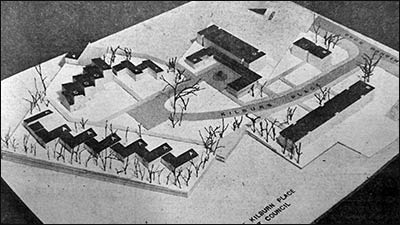 |
|
Model showing the layout for the development
|
This is a model of the proposed development scheme for Kilburn Place, Rushden – the plan aimed at the comfortable accommodation of old folk which has been approved for submission to the Ministry by Rushden Urban Council.
The architects, Talbot Brown, Panter and Partners, Wellingborough, have been instructed to prepare the necessary details with the view to tenders being invited. It is anticipated that the scheme will cost about £84,000, and that work will begin early this summer.
Layout
The layout has been designed with the idea of providing a pleasant view for as many residents as possible while retaining a good, all round aspect.
Most of the living rooms will look directly on to a central area, which will be lawned, and have pavings and suitable planting on its slope towards Higham Road and the south.
The block to the right, marked D, will consist of 18 bed-sitting rooms with kitchenettes attached, a guest room, communal laundry, bathrooms, and stores including a delivery entrance porch with lockers for each individual.
A warden’s bungalow (W) will be linked with this unit by means of an entrance hall containing a telephone kiosk, and so will a common or social room (E), by means of a covered approach.
A kitchenette with toilet facilities will be attached to the social room, which will be provided with a television set for general use.
The building marked (B) on either side of the entrance to Kilburn Place represents blocks of two-story self-contained one-bedroom flats (one of four unit and the other of twelve), while the building marked A representing nine one-bedroom bungalows. They are grouped on either side of C, which is a modern terrace unit of four two-story houses each with two bedrooms and adjacent garage and store.
The existing road layout will be extended to provide access to garages at the north end of the site (F) and to provide for vehicular access to the flatlet unit. In close proximity to the centre of the development will be six off-street parking units.
Footpaths will be provided to link all parts of the development with the central area, and the right of way at present in Oak Street will be retained and paved to become part of the scheme. A future footpath link to the north end of the site will also be included.
Insulation
The architects say that the units will be constructed in traditional materials and to the high standard of insulation necessary where heating generally is to be by thermostatically controlled floor heating. The only fire for solid fuel will be in the social room.
Outlets for television sets will be provided in each living unit, with an intercom system between each living unit except (C) which may be occupied by younger people.
The warden will be able to make direct contact with the elderly occupants at all times.
|
|
Leaflet produce by A.G. Crowdy, Clerk of the Council
Rushden Urban District Council
Kilburn Place Development
General description - December, 1966.
The development comprises 48 dwellings :-
| (a) |
A block of 18 flatlets, with a common room, guest room, warden's bungalow, etc. |
| (b) |
9 single bedroom bungalows |
| (c) |
16 self-contained single bedroom flats in two blocks (2 storeys) |
| (d) |
4 two-bedroomed houses |
| (e) |
5 garages |
Prior to the redevelopment 17 cottages and a large old house were cleared and the Council also acquired some adjoining land to provide a site of sufficient size for proper redevelopment. Architects were engaged to design the scheme in 1963 and the work was completed in May 1965.
The housing estates previously developed by the Council contain a number of flats and bungalows suitable for occupation by old people, but Kilburn Place was the first comprehensive development in Rushden to be planned with the needs of old people especially in mind. Whilst the accommodation on this site is not intended exclusively for the elderly, the development has been designed primarily to provide for their needs, as compared with the alternative of fitting old people into a scheme planned for general housing purposes.
Each flatlet is completely self-contained and comprises a sitting room with a bed-recess, and a kitchenette, and each tenant is therefore free to live an independent life, but the building also has a number of features to encourage the residents to enjoy each others company. Adjoining the flatlets, there is a well-furnished lounge or common room, which is a centre of social life, and the resident warden acts as "friend and neighbour" whenever need arises and helps with social arrangements. There is also a laundry, a trades delivery porch (with a locker for each tenant), a telephone kiosk, and a "guest room" available for booking, in which any visitor to a tenant can obtain overnight accommodation.
An "intercom" alarm system provides direct contact between the Warden's bungalow and each unit of accommodation (except the houses), thus enabling any tenant to summon help in case of need. Each dwelling is provided with a connection to a central television aerial which will provide a higher standard of reception than might otherwise be achieved with individual aerials.
Throughout the buildings extensive use has been made of underfloor electric heating, using off-peak electricity at the lower rate, with supplemental heating from individually controlled radiant fires, and hot water from electric storage heaters. The only fire using solid fuel is in the common room, and this has been included as an amenity feature rather than for heating.
The Architects have designed the whole development with the idea of providing a pleasant outlook for as many of the residents as possible. Most of the living rooms look out directly on to the central area, which has been laid out with grass, and the road layout includes parking spaces for visitors and tradesmen.
The total cost of the scheme was approximately £112,500 (including land acquisitions), and grants are received from the County Council towards the cost of the welfare services and special amenities, such as the warden's services, comoon room, etc.
Rents charged are:-
|
Per week
(inc. rates)
|
| Flatlets (including underfloor heating and hot water for baths) |
£1
|
16s
|
0d
|
| Flats (including underfloor heating) |
£2
|
3s
|
5d
|
| Bungalows |
£1
|
14s
|
5d
|
| Houses |
£2
|
1s
|
4d
|
| Garages |
|
9s
|
6d
|
|
The Architects responsible for the scheme were Messrs. Talbot Bromi, Panter and Partners, of Wellingborough, and the main contractors were P. Holyoak and Co. Ltd., of Finedon. Mr. J. A. Bishop, of Rushden, was the contractor for the original site works (roads and sewers).
The Council have provided a total of 1,716 houses and flats, 53 permanent bungalows and 50 pre-fabs.
|
The Rushden Echo, 30th April 1965, transcribed by Jim Hollis
Tenants complain at heating costs
Some of Rushden Urban Council’s tenants at Kilburn Place are complaining about the cost of heating the premises. The East Midlands Electricity Board has been asked to investigate and to provide a schedule showing the actual cost incurred so far, compared with the estimates of cost when the heating arrangements were approved.
The police are to be asked to deal with a case of a delivery vehicle parking on the footpath in High Street South. A complaint about obstruction in Albion Place is also to be referred to the police.
The clerk, Mr. A. G. Crowdy reported that he had referred a complaint from a resident in High Street South about noise from adjoining premises to the County Planning Officer.
The council approved a tender of £9,750 13s 2d from H. C. Mitchell and Son, Wymington, for erecting four bungalows and road works at Spinney Close.
The officers were asked to investigate complaints about the condition of a hedge at the rear of 81 Trafford Road, and an allegation of dressmaking being carried out from a council flat.
The council acted on two requests for street lamps in Hayden Road and on the footpath on Tennyson Road and Birchall Road.
On the latter it was decided to try to arrange with the County Education Committee for the school light, which is only used when evening classes are held to be controlled by a time switch so it can operate each night until midnight.
But it was decided to erect a lamp at Hayden Road at a cost of about £20.
|
The Rushden Echo, 2nd July 1965, transcribed by Jim Hollis
More than bricks and mortar
By Marian Potter
What is a home? Bricks and mortar, carpets and chairs …? It can be all of these things, but “home” cannot be measured in tangible – home it an atmosphere, a state of living, even a way of life.
The people who probably appreciate this more than anybody else in Rushden are the tenants of Kilburn Place, the recently opened old persons’ unit.
Although the first in Rushden, Kilburn Place, which was built by Rushden Urban Council, is not a new experiment in communal living for elderly people. It is not even the most progressive of its kind, but the tenants could make it one of the most successful.
No matter what schemes and gadgets are introduced the council has only provided a home in the physical sense. The tenants are making it into a real home by forming themselves into a social and welfare committee.
Independent
And the tenants are determined to remain independent. They aim to make the club financially self-supporting. The idea is to organise social events, such as outings, coffee evenings, whist drives and such.
In other words they are taking the idea of living together on a communal basis one step further – they are going to enjoy living together. There is the difference.
Kilburn Place consists of 16 flats, nine bungalows, 18 flatlets and four houses. About eighty people live on the estate, most of them of retirement age, and the warden is Mrs. D. Wilcox.
The idea of forming a social club was conceived at a coffee morning. No time was wasted in electing a committee and officers. They are: Mr. H. C. Whiting, chairman; Mr. A. Adams, secretary; Mrs. D. Wilcox, treasurer; committee, Miss G. Elliott, Miss G. Hilson, Miss D. Long and Mr. A. Law.
|
The Rushden Echo, 18th November 1966, transcribed by Jim Hollis
Exhibition Spotlight on Kilburn Place
Kilburn Place, a model housing estate off Rushden’s Higham Road, which caters especially for old people, has been included in an international “Building for Old People” exhibition at the Building Centre, London.
The exhibition opened in London on Tuesday and is being organised by the Building Centre Trust. It will travel round Britain and Europe after a spell in London, looking at projects and schemes for elderly folk.
The Rushden scheme, an imaginative and far-sighted project, was developed by Rushden Urban Council, and was designed by Talbot Brown, Panter and Partners, the Wellingborough architects.
Main contractors were P. Holyoak and Co. Ltd, of Finedon. Mr. J. A. Bishop of Rushden was the contractor for the original site work.
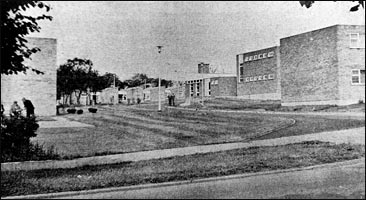 |
|
The new housing
|
The estate was completed in 1965 after two years’ work. It is the first comprehensive development in Rushden to be planned with the needs of old people especially in mind. While the accommodation on this site is not intended exclusively for the elderly, the development has been designed primarily for their needs, as compared with the alternative of fitting old people into a scheme planned for general housing purposes.
Main feature of the project is the block of 18 flats for old people. The flats are purposely designed as the type of accommodation most suitable for people of advancing years, who are less active and therefore less able to live completely independently of others.
Each flatlet is completely self-contained and comprises a sitting room with a bed-recess, and a kitchenette. Each tenant is therefore free to live an independent life. The building has, of course, a number of features to encourage residents to enjoy each other’s company.
Adjoining the flatlets there is a well-furnished lounge or common room. This, it was hoped, would become the centre of their social life.
A resident warden lives in the adjacent bungalow, ready to act as “friend and neighbour” whenever the need arises and to help with social arrangements.
There is also a laundry, a trades delivery porch (with locker for each tenant), a telephone kiosk, and a guest room available for booking, in which any visitor to a tenant can obtain overnight accommodation.
Cleaning
Cleaning of the accommodation is undertaken by staff employed for the purpose.
In addition to the flatlets the council have provided on the same site nine single-bedroom bungalows, two blocks containing 16 self-contained one-bedroomed flats, and a terrace of four two-storey houses, each with two bedrooms, and five garages. Most of this accommodation is eminently suitable for occupation by old people.
An “intercom” alarm system provides direct contact between the warden’s bungalow and each unit of accommodation except the houses. This enables any tenant to summon help in case of need.
Each dwelling is provided with a connection to a central television aerial which will provide a higher standard of reception than might be received on individual aerials.
Pleasant
The architects have designed the whole development with the idea of providing a pleasant outlook for as many of the residents as possible.
Most of the living rooms look out directly on to the central area, laid out with grass and suitable plants on the slope towards the south.
The road layout includes parking space for visitors. This is the first development on a community basis in the area and has succeeded admirably in its aim to become a happy unit, for since its completion only a year ago, the residents on their own initiative have formed a Kilburn Place Social Club.
|
The Rushden Echo, 20th October 1967, transcribed by Jim Hollis
Rushden Leading The County With Bold New Experiment
Day centre plan to cheer elderly
Rushden may not be the biggest town in the county – but what it lacks in size it makes up for in heart. This was graphically illustrated on Monday when 12 old folk in Rushden took part in a social experiment which could well set the pace for the county.
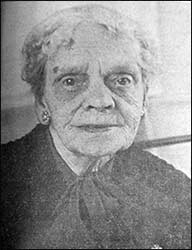 |
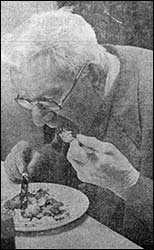 |
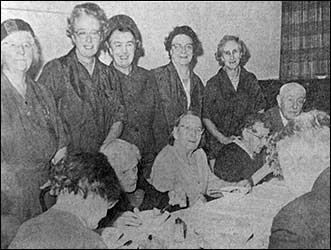 |
Mrs Lizzy Jacques (87) says:
“It’s very nice”
|
Ninety-five-year-old Mr Henry Bazeley enjoys his lunch at the new Day Club
|
WRVS members with some of the old folk
in the Kilburn Estate Common Room on Monday
|
The senior citizens – guests of the local WRVS – were brought together in the Common Room of the Kilburn Estate for the first Day Club meeting held in Northamptonshire.
The Day Club differs from existing social groups for the elderly in that it takes the elderly – and often lonely – folk away from their homes for a whole day instead of just a few hours in the afternoon or evening.
Member are collected by the Rushden WRVS in the morning and ferried home again in the evening. Lunch is served in the meeting place and each person also receives coffee soon after morning arrival and tea before going home.
Indoor games, including draughts, dominoes and cards are provided, and members can take part in these or just read or chat.
Most of the first 12 members were in their 80s and 90s and were obviously delighted with this new idea.
“Some of the group recognised friends they have not seen for twenty years,” Mrs. Audrey Perkins, central organiser of the WRVS Rushden Centre said.
Although they are taking only twelve at a time now, the WRVS hope to extend this later. Already there have been enquires from relatives of elderly people in the town who are anxious for them to attend the club. Gatherings will be on a rota basis so that everyone has an opportunity to come.
|
|